That’s great: at the bottom of this page, you can enter your own time and distance!
[
 Dutch version]
Dutch version]
Some time ago, I discussed (and calculated!) that you shouldn’t be thinking while running, at least not when you already know whereto and how fast, but that is even more a motivation to do that beforehand. And, while running, dig the answers from your memory. 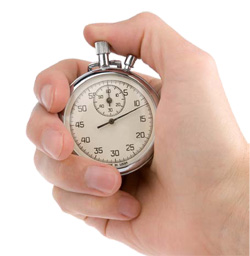 That’s the reason for this article.
That’s the reason for this article.
Let’s start simple: for once and for all -and that will be this year- I want to finish the Half Marathon within the one-and-a-half. So, that is 21.098 kilometer in 90 minutes. Dividing those figures results in a speed of 14.06 km/h (or 8.74 mph). With some experience I gained, I got a feeling for that speed. But still, it’s better to comprehend when express it as 234 meter per minute. And it sounds quite fast when I say 3.91 m/s (meter per second), which is about twice what I’m tall.
Since I take part in Orienteering races, the pace started to make sense to me (and because my GPS watch tells me). And now I know what it means to run 4’16”/km (4 minutes and 16 seconds per kilometer, or 6’52”/mile). 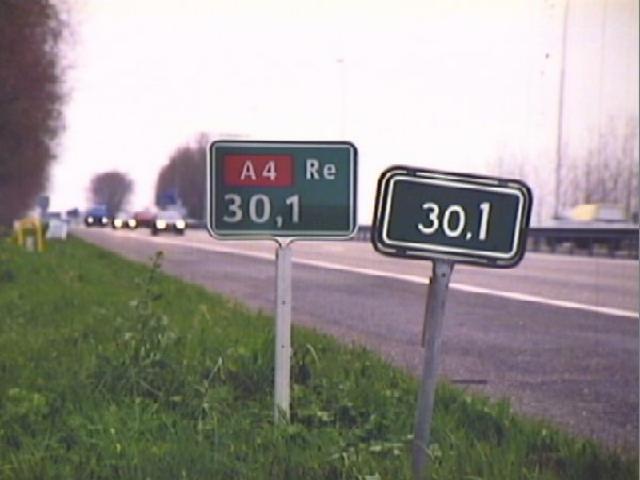 I get a feeling for it. And, because I know that I have to keep that pace on the Half Marathon, it’s my reference for everything. 4’00” /km sounds already very quick, but recently, while training intervals with some colleagues, we incited each other easily to below 03’50” /km, and even with a sprint at the end, of 03’40” /km. Yet again, it’s easier to survey 100 meter than 1 km, especially when you want to estimate a distance on the road (the same as between the two ‘hectometerpaaltjes’). And, for my desired pace, I need to accomplish those 100 m within 25.60 seconds.
I get a feeling for it. And, because I know that I have to keep that pace on the Half Marathon, it’s my reference for everything. 4’00” /km sounds already very quick, but recently, while training intervals with some colleagues, we incited each other easily to below 03’50” /km, and even with a sprint at the end, of 03’40” /km. Yet again, it’s easier to survey 100 meter than 1 km, especially when you want to estimate a distance on the road (the same as between the two ‘hectometerpaaltjes’). And, for my desired pace, I need to accomplish those 100 m within 25.60 seconds.
But what occupies me most, on my way, are the relative differences: how much faster should I run per 100 meter to finish one minute quicker? And, while running, I am typically not fit enough to realize that one minute contains about 60 seconds, so for each individual kilometer of the 21, that is let’s say 3. Or 0.3 seconds per 100 meter. That’s nothing! If that’s all for a finish time that’s one minute better, give me 10!
Below, a table, to observe the trends:
| time | speed | pace | difference | |||||||
| hh:mm | km/h | m/min | m/s | min/km | s/hm | % | s/km | s/hm | pas/s | pas/min |
| 01:20 | 15.82 | 264 | 4.39 | 00:03:47.54 | 22.75 | 1.45 | 87.02 | |||
| 01:25 | 14.89 | 248 | 4.14 | 00:04:01.76 | 24.18 | 1.18 | 2.84 | 0.28 | 1.36 | 81.90 |
| 01:26 | 14.72 | 245 | 4.09 | 00:04:04.61 | 24.46 | 1.17 | 2.84 | 0.28 | 1.35 | 80.95 |
| 01:27 | 14.55 | 242 | 4.04 | 00:04:07.45 | 24.75 | 1.16 | 2.84 | 0.28 | 1.33 | 80.02 |
| 01:28 | 14.38 | 240 | 4.00 | 00:04:10.30 | 25.03 | 1.14 | 2.84 | 0.28 | 1.32 | 79.11 |
| 01:29 | 14.22 | 237 | 3.95 | 00:04:13.14 | 25.31 | 1.13 | 2.84 | 0.28 | 1.30 | 78.22 |
| 01:30 | 14.06 | 234 | 3.91 | 00:04:15.98 | 25.60 | 1.12 | 2.84 | 0.28 | 1.29 | 77.35 |
| 01:31 | 13.91 | 232 | 3.86 | 00:04:18.83 | 25.88 | 1.10 | 2.84 | 0.28 | 1.27 | 76.50 |
| 01:32 | 13.76 | 229 | 3.82 | 00:04:21.67 | 26.17 | 1.09 | 2.84 | 0.28 | 1.26 | 75.67 |
| 01:33 | 13.61 | 227 | 3.78 | 00:04:24.52 | 26.45 | 1.08 | 2.84 | 0.28 | 1.25 | 74.85 |
| 01:34 | 13.46 | 224 | 3.74 | 00:04:27.36 | 26.74 | 1.07 | 2.84 | 0.28 | 1.23 | 74.06 |
| 01:35 | 13.32 | 222 | 3.70 | 00:04:30.21 | 27.02 | 1.06 | 2.84 | 0.28 | 1.22 | 73.28 |
You may have noticed that for every minute you subtract from your projected finish time, the required increase in speed, per minute, becomes larger. Not only the speed itself –that’s obvious– but the speed difference too. Meanwhile, the difference in pace is always the same. The relative difference, in %, of the time per 100 m changes, but the absolute difference, in s per 100 m, stays the same. It’s all logical, but it may be practical to remember while you’re on the go: time over distance (pace) is linear as a function of the finish-time; speed, and relative changes in pace, are inversely proportional.
When you run the first half 1″ per km slower than the 4’16”/km you should run, you will have to catch up those 21.098/2 s during the second half. To do that, you will have exactly half of the total 21098 m available. So you have to run exactly 1″ faster per km, than the overall average. The net difference is 2″/km with respect to you pace in the first half. Sounds easy.
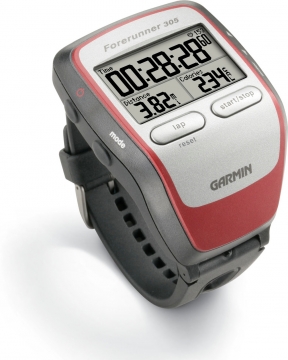 For 1:30:00, you will have to run precisely 4’15.98”/km. Your GPS is not that accurate, but fortunately it’s close to 4’16”/km. However, you will just miss your target time by 19 ms. That is 19 milliseconds –not much, but all your hairs grow about one atom in that time, still at total of about 1/100 of a mm altogether. You miss your target by 7.1 cm! But, if you would have run 4’15”/km (the difference is hardly visible on your GPS watch), that will gain you advantage of 21 s at the end. Just a matter of approximation. Again, this a figure that is easily remembered: for every 1 second you run faster than planned, on a distance of 21.098 km, you gain in the end as many seconds as there are kilometers. For every distance!
For 1:30:00, you will have to run precisely 4’15.98”/km. Your GPS is not that accurate, but fortunately it’s close to 4’16”/km. However, you will just miss your target time by 19 ms. That is 19 milliseconds –not much, but all your hairs grow about one atom in that time, still at total of about 1/100 of a mm altogether. You miss your target by 7.1 cm! But, if you would have run 4’15”/km (the difference is hardly visible on your GPS watch), that will gain you advantage of 21 s at the end. Just a matter of approximation. Again, this a figure that is easily remembered: for every 1 second you run faster than planned, on a distance of 21.098 km, you gain in the end as many seconds as there are kilometers. For every distance!
If your run a a bit slower, and have to cache up at the end, then it may be interesting to express that lag in meters. Just as if, at that moment, you pick another runner -who keeps running at a constant pace- that many meters in front of yourself, and strive to overtake him right at the finish. Suppose, you ran 1 second to slow per kilometer. Then, at the end, you have to catch up that 21.098 s lag, what, right at the end (which is in fact too late) boils down to 82 meter. This way, it sounds quite tough. And, when you find out 1 km before the finish, that all the time you aimed at a pace 01:31:00, one minute too slow, then you have to overtake, in that last km, someone who, at that moment, is 223 meter in front of you. No, you’re not going to make that.
There are a few things to remember: Suppose you’re in terrific shape, and it goes very smooth. You can keep a pace of 4’00” /km, then you will finish at 01:24:23 Fantastic! To get a feeling for those finish times, I have written them on a dial: thinking in time like an old-fashioned clock is -for me at least- still the most intuitive representation. On top of the dial it says 4’00”, and ever second/km more counts clockwise. Can you print this one on your retina? 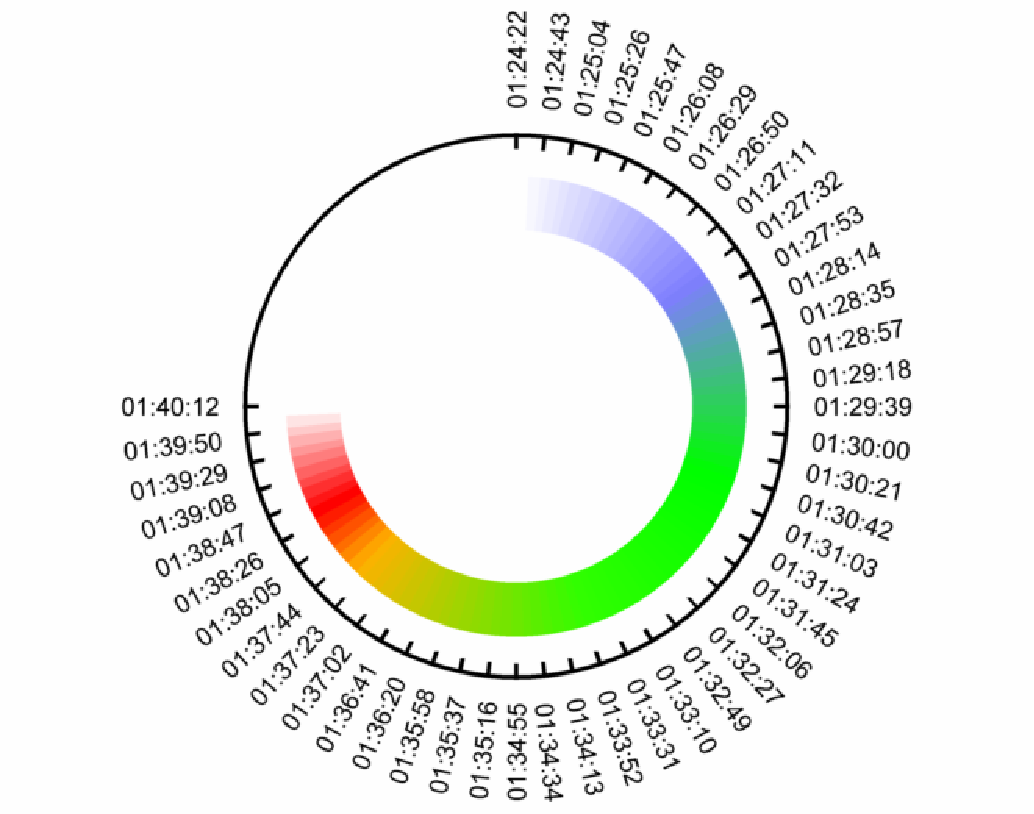
The moral of the story? Just run just below the 4’16” /km, and you need not think about anything. That saves a lot of energy!
 Enlish version
Enlish version boven een samenvatting van deze wedstrijd staan? Dat is nieuw. Heb ik alle relevante getallen en links naar kaart, video, splits en uitslagen in gezet. Alleen wil dit nog niet printen, maar daar vind ik wel wat op.
boven een samenvatting van deze wedstrijd staan? Dat is nieuw. Heb ik alle relevante getallen en links naar kaart, video, splits en uitslagen in gezet. Alleen wil dit nog niet printen, maar daar vind ik wel wat op.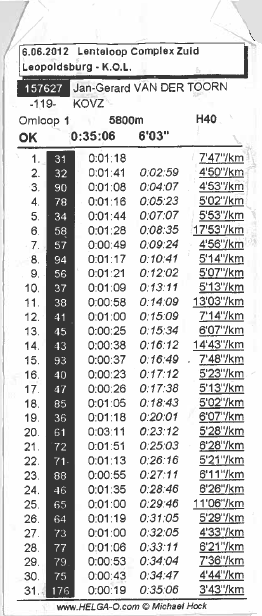 Terug naar de wedstrijd. Sowieso weer een mooi avontuur. Voor het eerst een sprint, korte afstandjes, veel posten, en in een “stedelijke” omgeving. Nou ja, stedelijk? We liepen over een schijnbaar verlaten militair kazerne-terrein. Tanks her en der, maar nergens mannetjes in groene pakken te zien. Door alle gebouwen en andere objecten was het echter uitstekend oriënteren. Soms was er geen kunst aan!
Terug naar de wedstrijd. Sowieso weer een mooi avontuur. Voor het eerst een sprint, korte afstandjes, veel posten, en in een “stedelijke” omgeving. Nou ja, stedelijk? We liepen over een schijnbaar verlaten militair kazerne-terrein. Tanks her en der, maar nergens mannetjes in groene pakken te zien. Door alle gebouwen en andere objecten was het echter uitstekend oriënteren. Soms was er geen kunst aan! De langste afstand was, in vogelvlucht, 5800 meter. Best kort, dus ik dacht er nog even over om twee omlopen te doen. Maar het bleek maar goed dat ik dat niet deed, want sprint is ook echt sprint, en bij de finish voelde ik dat ik alles gegeven had. Pittig! En leuk, om zo hard te gaan. Misschien let ik de volgende keer tevoren wel beter op als ik mijn tas inpak, en stop ik mijn weg-schoenen er in in plaats van mijn nieuwe Inov-8’s met stalen noppen. Want die maken zo’n herrie op straten en stoepen, waar het hier vol mee lag.
De langste afstand was, in vogelvlucht, 5800 meter. Best kort, dus ik dacht er nog even over om twee omlopen te doen. Maar het bleek maar goed dat ik dat niet deed, want sprint is ook echt sprint, en bij de finish voelde ik dat ik alles gegeven had. Pittig! En leuk, om zo hard te gaan. Misschien let ik de volgende keer tevoren wel beter op als ik mijn tas inpak, en stop ik mijn weg-schoenen er in in plaats van mijn nieuwe Inov-8’s met stalen noppen. Want die maken zo’n herrie op straten en stoepen, waar het hier vol mee lag.
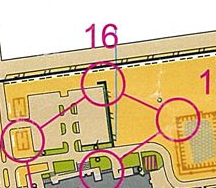 zonder over het hekje heen te klimmen. Gewoon met de hand. Mag dat? Ik hoorde achteraf van niet. Hoeveel mensen zouden zijn omgelopen?
zonder over het hekje heen te klimmen. Gewoon met de hand. Mag dat? Ik hoorde achteraf van niet. Hoeveel mensen zouden zijn omgelopen?
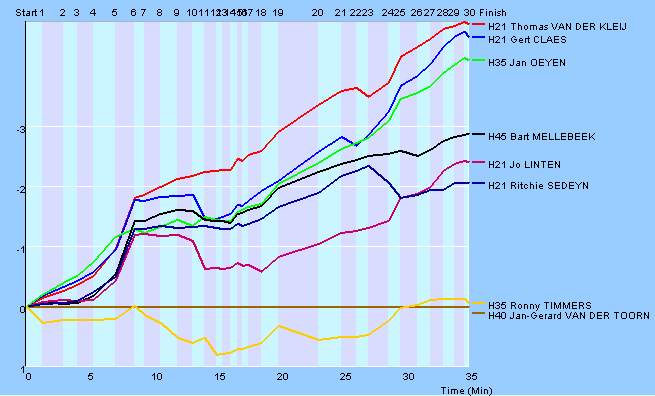
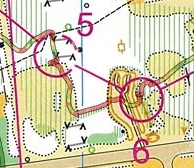
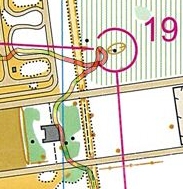
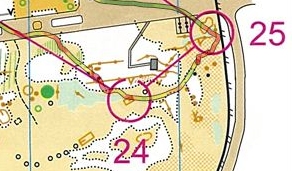
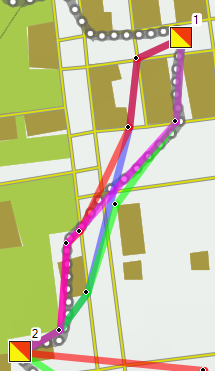 Op weg van post 1 naar 2 kan je op vier manieren lopen. Groen is in het plaatje de kortste optie (371 m), blauw en magenta (mijn route), zijn even lang (381 m), en rood is met 384 m het langst. Maar het scheelt hooguit 13 meter. Wat is dat nou?
Op weg van post 1 naar 2 kan je op vier manieren lopen. Groen is in het plaatje de kortste optie (371 m), blauw en magenta (mijn route), zijn even lang (381 m), en rood is met 384 m het langst. Maar het scheelt hooguit 13 meter. Wat is dat nou?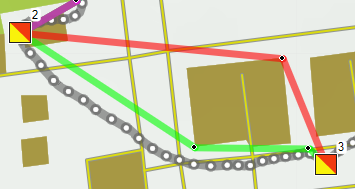 Van 2 naar 3 zijn er ook twee mogelijkheden, maar hier is de groene met 245 m overduidelijk korter dan de rode route van 267 m.
Van 2 naar 3 zijn er ook twee mogelijkheden, maar hier is de groene met 245 m overduidelijk korter dan de rode route van 267 m.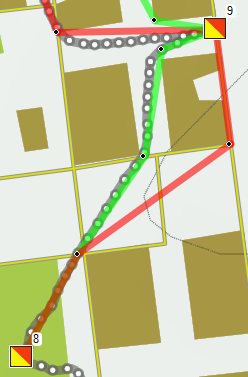 Van 8 naar 9 kan je ook op meerdere manieren, maar het verschil lijkt duidelijker dan het is: 14 meter op een totaal van 282 m. Nou ja, dat is toch 5%, dus als je een paar procent wilt winnen is dit toch lonend. Bovendien kom je dan bij 9 op een gunstiger manier aanlopen, en zie je de post al staan, alhoewel dat tevoren nog niet zo duidelijk was.
Van 8 naar 9 kan je ook op meerdere manieren, maar het verschil lijkt duidelijker dan het is: 14 meter op een totaal van 282 m. Nou ja, dat is toch 5%, dus als je een paar procent wilt winnen is dit toch lonend. Bovendien kom je dan bij 9 op een gunstiger manier aanlopen, en zie je de post al staan, alhoewel dat tevoren nog niet zo duidelijk was.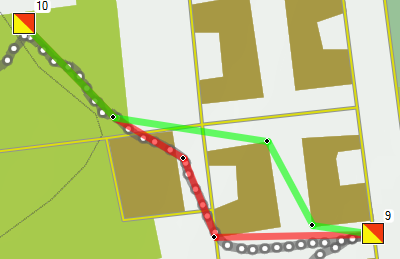 Op weg van 9 naar 10 viel 8 meter te winnen (of te verliezen, zoals ik deed). Maar ik denk dat dat op de echte kaart wel eens mee zou kunnen vallen, omdat de gebouwen wat breder zijn dan hier getekend. Alleen heb ik nog geen handig tooltje gevonden om op bitmaps te tekenen (ik kan ze wel als GoogleMap overlay in mijn browser krijgen) en om lengtes van lijnen/routes te bepalen (tekenen op een Google map gaat wel, maar dan weer niet op een Custom-overlay), dus heb ik hier Mapsource voor gebruikt.
Op weg van 9 naar 10 viel 8 meter te winnen (of te verliezen, zoals ik deed). Maar ik denk dat dat op de echte kaart wel eens mee zou kunnen vallen, omdat de gebouwen wat breder zijn dan hier getekend. Alleen heb ik nog geen handig tooltje gevonden om op bitmaps te tekenen (ik kan ze wel als GoogleMap overlay in mijn browser krijgen) en om lengtes van lijnen/routes te bepalen (tekenen op een Google map gaat wel, maar dan weer niet op een Custom-overlay), dus heb ik hier Mapsource voor gebruikt.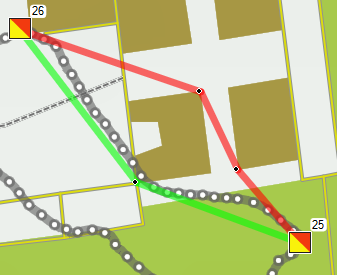 En tenslotte was er nog het been van 25 naar 26. Ook hier weer blijk ik de juiste keuze gemaakt te hebben, en heb de 5 meter kortere route gekozen. Poeh, wat knap! Op de 258 resp. 263 meter maakt dat nou niet ze heel veel uit.
En tenslotte was er nog het been van 25 naar 26. Ook hier weer blijk ik de juiste keuze gemaakt te hebben, en heb de 5 meter kortere route gekozen. Poeh, wat knap! Op de 258 resp. 263 meter maakt dat nou niet ze heel veel uit.
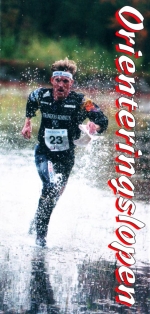 rood-witte sierletters Oriënteringslopen staat. Prompt heb ik de titel van mijn weblog aangepast. Toch zat het nog niet lekker. Ik heb deze vraag dus maar op het I-OL.nl forum gepost. Er ontstond meteen een discussie. Nu, een paar maanden later, is deze wel uitgedenderd.
rood-witte sierletters Oriënteringslopen staat. Prompt heb ik de titel van mijn weblog aangepast. Toch zat het nog niet lekker. Ik heb deze vraag dus maar op het I-OL.nl forum gepost. Er ontstond meteen een discussie. Nu, een paar maanden later, is deze wel uitgedenderd.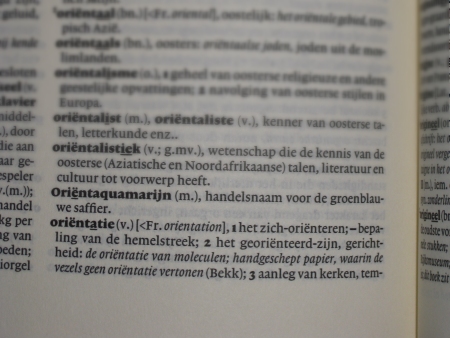
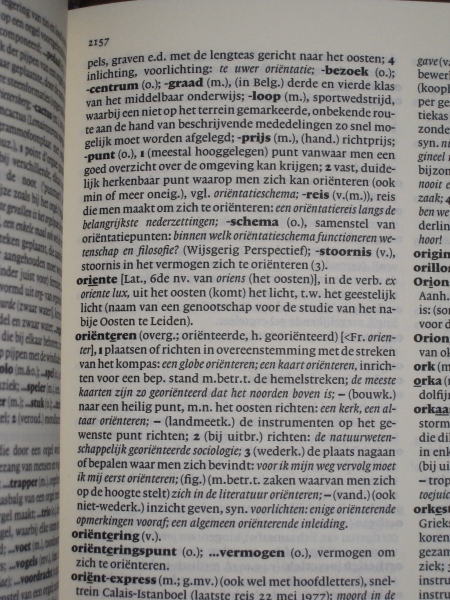
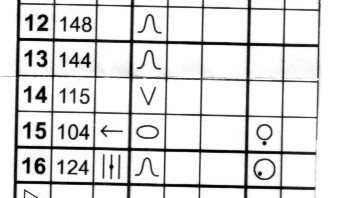

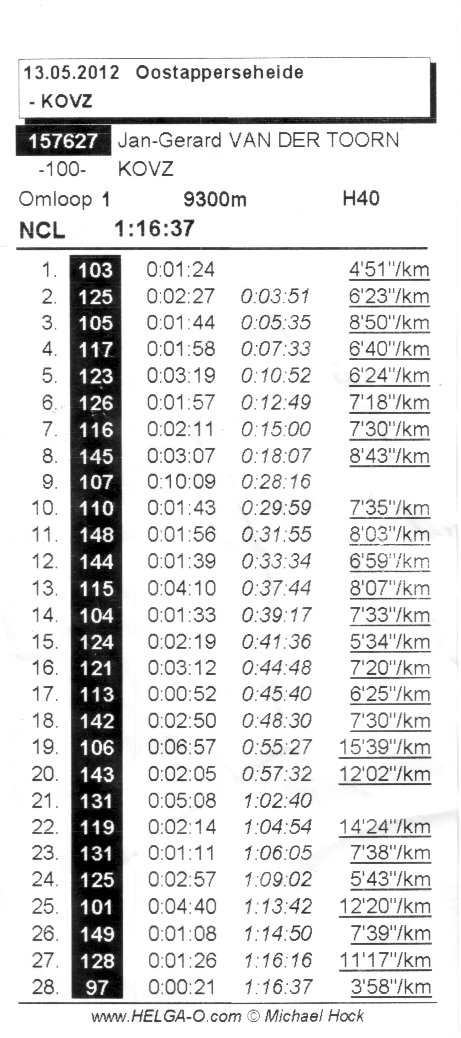
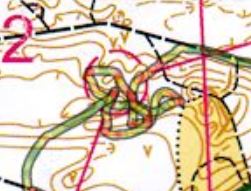


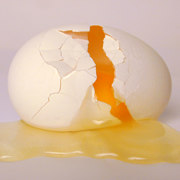
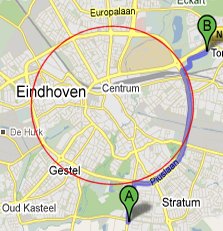
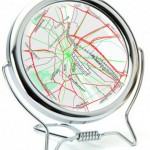
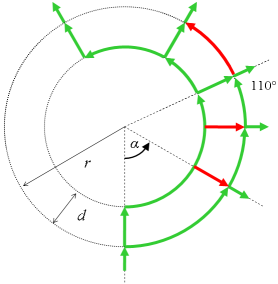 Laat de breedte van de rondweg d [meter] zijn, en de straal r. En je loopt vanaf 0° tot aan hoek α. Voor de berekening gebruiken we even
Laat de breedte van de rondweg d [meter] zijn, en de straal r. En je loopt vanaf 0° tot aan hoek α. Voor de berekening gebruiken we even 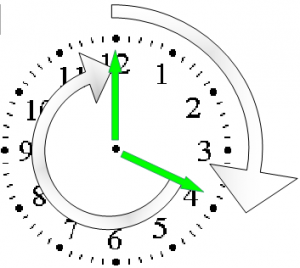 Onthoud dat goed: moet je meer dan één Pi-de deel van een taartpunt (een pie) rond een punt, neem dan voortaan de binnenbocht. En anders, ook al lijkt het om, kan je beter in de buitenbocht blijven.
Onthoud dat goed: moet je meer dan één Pi-de deel van een taartpunt (een pie) rond een punt, neem dan voortaan de binnenbocht. En anders, ook al lijkt het om, kan je beter in de buitenbocht blijven.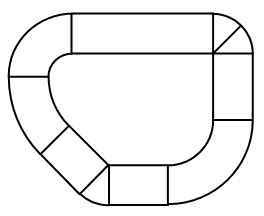 Je kan je trouwens nog even af gaan lopen vragen of het uitmaakt of de betreffende rondweg rond is, ei-vormig, onregelmatig, met rechte stukken er in, maar dat hoeft niet lang te duren want hier is het antwoord: Nee! Zo lang de binnen- en buitenbocht maar overal even ver uit elkaar liggen, en de weg overal convex is, gaat bovenstaande altijd op.
Je kan je trouwens nog even af gaan lopen vragen of het uitmaakt of de betreffende rondweg rond is, ei-vormig, onregelmatig, met rechte stukken er in, maar dat hoeft niet lang te duren want hier is het antwoord: Nee! Zo lang de binnen- en buitenbocht maar overal even ver uit elkaar liggen, en de weg overal convex is, gaat bovenstaande altijd op.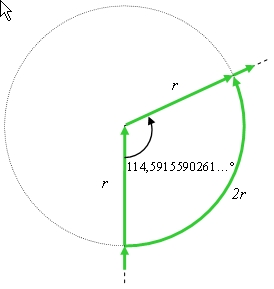
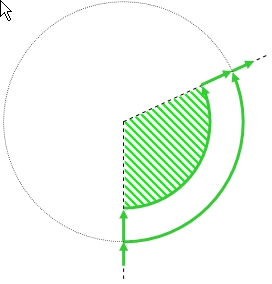 Geldt dat dan ook voor een weg van beperkte breedte? Ja! Want als ik bij deze specifieke hoek net zo goed om kan lopen als af kan snijden, kan ik ook evengoed en “hap” ter grootte van dit cirkelsegment uit een groter cirkelsegment nemen. En de resterende vorm is weer een stukje rondweg, met een even lange binnen- als buitenbocht. Q.E.D.
Geldt dat dan ook voor een weg van beperkte breedte? Ja! Want als ik bij deze specifieke hoek net zo goed om kan lopen als af kan snijden, kan ik ook evengoed en “hap” ter grootte van dit cirkelsegment uit een groter cirkelsegment nemen. En de resterende vorm is weer een stukje rondweg, met een even lange binnen- als buitenbocht. Q.E.D.